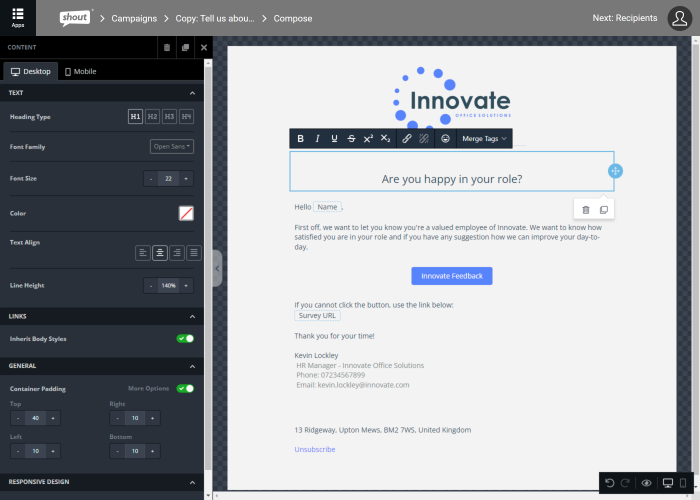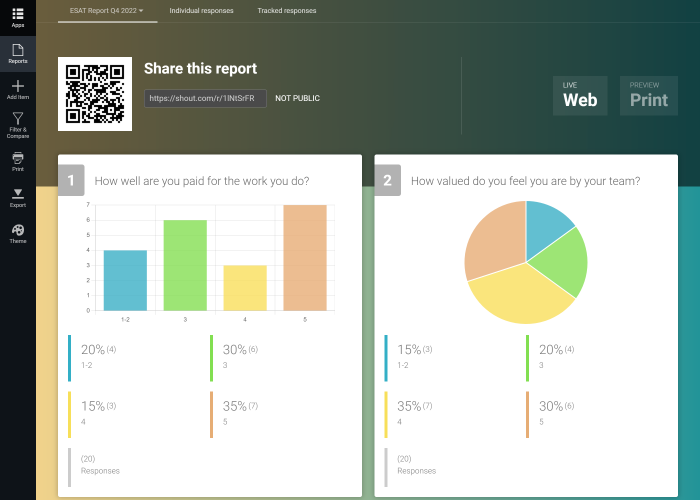FEATURES FOR EMPLOYEE SATISFACTION SURVEYS
Measure satisfaction and reduce staff turnover
Robust features to encourage compliance and protect employee data whilst collecting actionable feedback.
Compliant employee CRM
Import employees to the CRM, group them based on role or seniority, and track the lawful basis for processing their data (e.g. Contract).
Measure your eNPS
Ask employees how likely they are to recommend your business as a place to work with our Net Promoter Score question type.
Benchmark satisfaction
Measure employee satisfaction with a recurring survey and use crosstabs to compare results over time.
Departmental collaboration
Invite other department heads to join your Shout team, share your features, and measure employee satisfaction from their own accounts.
Brand everything
Add your logo, customize the designs of employee surveys and emails, and white label surveys to align with your brand guidelines.
Automate quiz scoring
Create quizzes to increase engagement, improve job satisfaction with assessments, and onboard new hires with training.
Connect with employees and track interactions

Transform data into employee satisfaction

Collect feedback in a way that suits you
Compliance built in, for teams of any size
An integrated CRM, for managing employees the compliant way
Group employees based on department, role and seniority, and track the lawful basis for processing their data in the app.
Private accounts for each department, with centralized billing
Team user surveys are private by default, so no one has access to survey data that isn’t relevant to them.
Separate personally identifiable information from survey responses
Enable pseudonymization to separate any personal information from question data in your reports.
Reduce employee turnover with Shout
14 Day Free Trial • Cancel Any Time • No Credit Card Required
Employee Satisfaction FAQs
Everything you need to know about employee satisfaction surveys and how they can help you increase happiness in the workplace.
Employee satisfaction refers to the overall contentment and fulfillment that employees feel about their work within an organization. It involves creating an environment where employees are happy, engaged, and motivated to contribute their best efforts.
Employee satisfaction is gauged through various channels, including regular feedback mechanisms, where employees can share their opinions and insights about their work experiences.
This feedback serves as a valuable tool for organizations to understand how employees feel about their roles, the work environment, and the overall workplace culture. Implementing long-term strategies to enhance employee satisfaction involves developing action plans based on the feedback received.
Organizations can address specific concerns, recognize achievements, and foster a positive work atmosphere. By prioritizing employee satisfaction and continually refining the work environment, organizations can promote employee well-being, loyalty, and productivity over the long term.
Some elements that may factor into employee satisfaction are:
- Work culture.
- Manager relationships.
- Performance feedback.
- Salary.
- Work/ life balance.
- Deadlines.
The happier an employee is, the more of themselves they’ll invest in your company, its mission and goals. High levels of satisfaction often lead to a better quality of customer service and more efficiency in the workplace.
They can also be incredibly important to human resource departments, who can use this feedback to reduce employee turnover.
By asking for employee feedback, you can identify the strengths and weakness of your company culture and improve employee morale and engagement.
When creating an employee satisfaction survey, you must consider the factors that influence their experience. These could include daily tasks, leadership structures, benefits, work environment, the performance of colleagues and managers and opportunities for career development.
Anything that could impact their performance, motivation and commitment to the role should be addressed.
If the results of your staff satisfaction survey show that there is unhappiness or resentment concerning other team members, you may want to consider running 360-degree feedback surveys.
Here are some examples of questions for your employee satisfaction surveys:
- Does your manager value you feedback?
- Do you feel you have a good work/ life balance?
- Is your role clearly defined to you?
- Are you satisfied overall with your job?
- Does your team provide you support when you need it?
- Do you feel rewarded for the work you do?
- Do you feel valued in the company?
- Do you feel proud to work for the company?
Typically, ESAT surveys consist of multiple-choice, matrix, and text-based questions. But to reduce survey fatigue, we recommend using a wider range of question types, such as binary yes/no, order rankings, and sliders.
